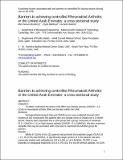Barriers to achieving controlled rheumatoid arthritis in the United Arab Emirates: a cross-sectional study
Author(s)
Mahfoud, Ziyad; Badsha, Humeira; Moufarrej, Mira N.
Download296_2014_3151_ReferencePDF.pdf (483.8Kb)
PUBLISHER_POLICY
Publisher Policy
Article is made available in accordance with the publisher's policy and may be subject to US copyright law. Please refer to the publisher's site for terms of use.
Terms of use
Metadata
Show full item recordAbstract
To better understand the factors that affect low disease activity (DAS28 ≤ 3.2, LDA) in rheumatoid arthritis (RA) and barriers within the UAE, demographic/treatment data and DAS28 scores were collected through chart reviews of 182 consecutive RA patients seen at a private clinic in Dubai over a 2-month period. Patients were separated into a LDA group and a group comprised of moderate (3.2 < DAS28 < 5.1) or high disease activity (DAS28 ≥ 5.1) (MHDA). We then examined variables that may be associated with LDA and re-examined the MHDA group for barriers. While 97 (53 %) of the 182 patients had achieved the treatment target of DAS28 ≤ 3.2, 85 (47 %) had MHDA. A significantly larger portion of LDA patients had been previously treated with sulfasalazine (36 in LDA vs. 14 in MHDA, P = 0.002) or was presently on biological treatments (24 vs. 9, P = 0.013). For the 85 MHDA patients, 40 (22 % of 182) exhibited resistant disease with 25 (13.7 % of 182) failing their current first tier disease-modifying anti-rheumatic drug (DMARD) treatment or combinations and 15 (8.2 % of 182) failing current anti-TNF or biologic treatment. Reasons listed were primarily socioeconomic with 40 % of the resistant disease group unable to afford biologicals and 52 % of the patient-driven preference group discontinuing DMARDs against professional advice. Going forward, emphasis on the agreement between patient and rheumatologist on treatment, specifically regarding how DMARDs help relieve symptoms and their proper use, could help reduce the percentage of MHDA patients in the UAE.
Date issued
2014-10Department
Massachusetts Institute of Technology. Department of Biological EngineeringJournal
Rheumatology International
Publisher
Springer Berlin Heidelberg
Citation
Moufarrej, Mira Noura, Ziyad Mahfoud, and Humeira Badsha. “Barriers to Achieving Controlled Rheumatoid Arthritis in the United Arab Emirates: a Cross-Sectional Study.” Rheumatology International 35, no. 4 (October 15, 2014): 759–763.
Version: Author's final manuscript
ISSN
0172-8172
1437-160X